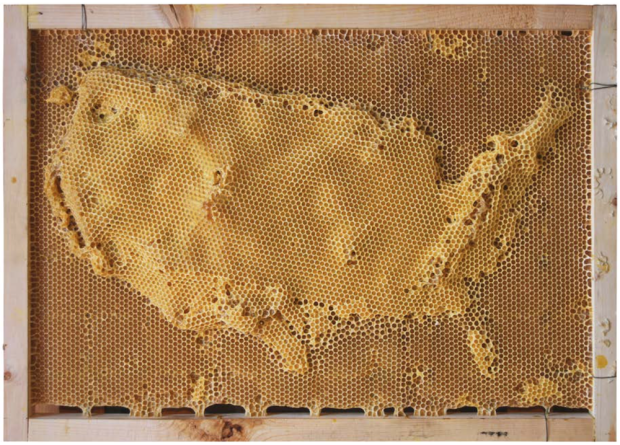 In my random Netflix perusal, I came across a documentary about the striking loss of bee populations, The Vanishing of the Bees. I hadn’t realized this, but in industrial scale farming a large amount of pollinators are needed to pollinate fields of crops, many more pollinators than live in the area normally. Bee farmers fill this role by cultivating large colonies of bees. They move these bees around the country in semi-trucks to farms where they are needed. These bees are experiencing “colony collapse disorder” where entire colonies of bees are wiped out. Without pollinators, many crops will be drastically affected. Fellow blogger Michele has posted artwork that tries to draw attention to the plight of the bees.
In my random Netflix perusal, I came across a documentary about the striking loss of bee populations, The Vanishing of the Bees. I hadn’t realized this, but in industrial scale farming a large amount of pollinators are needed to pollinate fields of crops, many more pollinators than live in the area normally. Bee farmers fill this role by cultivating large colonies of bees. They move these bees around the country in semi-trucks to farms where they are needed. These bees are experiencing “colony collapse disorder” where entire colonies of bees are wiped out. Without pollinators, many crops will be drastically affected. Fellow blogger Michele has posted artwork that tries to draw attention to the plight of the bees.
While the research into colony collapse disorder is very complex and implicates multiple factors including diseases and pesticides, the documentary focuses on the potential contribution of pesticide exposure to this disorder.
The documentary suggests that FDA testing of pesticides is inadequate testing. Pesticides levels that are not lethal to individual bees could have effects that are detrimental to colonies. At the time of the filming, there wasn’t much known about why exactly these colonies of bees were being wiped out.
Pesticide use has been an obvious area of research interest. In the last year, Science Magazine published a study from the UK that found bees exposed to levels of pesticide found in the pollen and nectar of crops grew more slowly and made many fewer queen bees. This could be a really big problem because the queen bees repopulate bee colonies after the winter. Science Magazine also published research from another group in France that found a large number bees exposed to low levels of pesticides failed to return to the hive after foraging for food. The number of bees lost in each foraging expedition could seriously disrupt the maintenance of colony numbers.
In the most recent study published last week in the journal Nature, UK researchers show that a combination of low-level pesticides is even more devastating to bee colonies. Currently, these pesticides aren’t tested in combinations for their effects on the bees. Bees often experience this combination when visiting multiple fields during foraging or being transferred to new crops in the case of industrial farming. Bees seeing multiple pesticides don’t forage effectively and die much earlier. To compensate, bees that normally care for the young bees in the hive are sent out to forage which leads into a cycle of reduced production of young bees just exacerbating the problem. This illustrates that non-lethal doses of pesticides can have serious effects on the bees.
These studies do not show that pesticide use is causing current problems with colony collapse disorder. They do highlight the fact that any treatment we apply to crops is not necessarily acting in isolation. While this research may not lead to a solution for colony collapse disorder, hopefully, this research will help inform future choices on pesticide use and regulation.
If you’re feeling down about the bees and need something to brighten your day, one of my favorite bands (The Octopus Project) has a song titled “Bees Bein’ Strugglin” check it out!
Editor’s Note: Researcher and insect photographer Alex Wild raised the concern that the original version of this article did place the research referenced in the complex context that is colony collapse disorder. While the article focuses on current research published in Science and Nature relevant to the documentary in question, we have amended the article to better represent the complexity of this dynamic field of research. If you wish to view the original version, you can download a PDF version (324kb) here.







